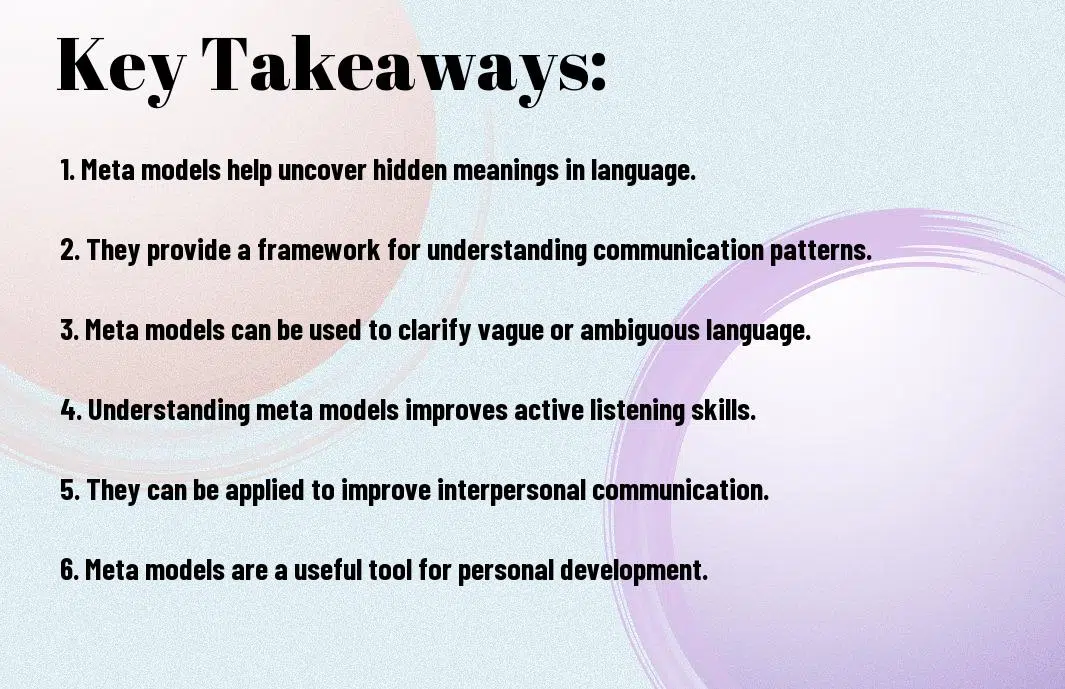Have you ever wondered about the underlying structure of language and how it shapes the way we perceive and interpret the world around us? In the field of Neuro-Linguistic Programming (NLP), understanding and mastering meta models is essential for effective communication and behavioral change. In this blog post, you will delve into the world of meta models, exploring their significance and uncovering their potential impact on your everyday interactions.
Meta models in NLP serve as a powerful tool for enhancing your communication skills and gaining deeper insights into the thoughts, beliefs, and behaviors of yourself and others. By challenging and clarifying the language we use, meta models offer the opportunity to uncover hidden assumptions, break down barriers, and open up new perspectives. Whether you are a professional looking to improve your leadership and negotiation skills or simply seeking to enhance your personal relationships, understanding meta models is a crucial step towards effective communication and personal growth.
Key Takeaways:
- Understanding Meta Models: Meta models are a key component of NLP and serve as a tool for understanding and analyzing language patterns in communication.
- Uncovering Limiting Beliefs: By exploring meta models, individuals can identify and challenge their own limiting beliefs, leading to personal growth and development.
- Enhancing Communication Skills: Learning about meta models can improve communication skills by enabling individuals to ask more specific and effective questions in conversations, leading to clearer understanding and rapport-building.
Foundations of NLP
Even before delving into the intricate world of natural language processing (NLP), it is essential to have a solid understanding of its foundational elements. This will provide you with the context necessary to comprehend the intricacies and the potential impact of NLP on various fields and industries. In this chapter, we will explore the foundational aspects of NLP that shape its methodologies and applications.
Defining Natural Language Processing
Defining natural language processing (NLP) can be complex, as it encompasses various aspects of linguistic, cognitive, and computer science theories. At its core, NLP is a field of artificial intelligence that focuses on enabling computers to understand, interpret, and manipulate human language. This involves programming computers to process and analyze large amounts of natural language data, learn from it, and generate human-like responses. Whether it’s understanding spoken language, translating languages, or generating human-like responses, NLP plays a critical role in bridging the gap between human communication and machines. The ability of NLP to extract meaning from human language, process it, and generate appropriate responses is a revolutionary capability that continues to shape the way we interact with technology and the world around us.
Interdisciplinary Roots: Linguistics, Computer Science, and Artificial Intelligence
NLP has deep roots in various interdisciplinary fields, including linguistics, computer science, and artificial intelligence. The understanding of human language and its structure is derived from linguistics, while the computational algorithms and data processing techniques come from computer science. Additionally, the development of intelligent systems that can process and generate human-like responses falls within the realm of artificial intelligence. The amalgamation of these diverse disciplines is what makes NLP a powerful and versatile field with the potential to revolutionize the way we interact with technology. By drawing from these diverse areas of study, NLP has the potential to not only understand human language but also replicate and respond to it in a manner that is indistinguishable from human communication.
Delving into Meta Models
Not sure what a meta model is in the context of NLP? Let’s dive deeper into this concept and uncover its significance in understanding language patterns and communication.
The Concept of Meta Models in NLP
When it comes to Neuro-Linguistic Programming (NLP), meta models play a crucial role in deciphering the structure and meaning of language. The term “meta model” essentially refers to a set of linguistic patterns or models that can help you uncover and understand the underlying structure of someone’s language, thereby allowing you to gain deeper insight into their thoughts and beliefs.
Types of Meta Models and Their Functions
In NLP, there are several types of meta models, each serving a distinct function in analyzing and understanding language patterns. These meta models include deletion, generalization, and distortion, all of which provide valuable insight into how language can be used to express and communicate thoughts and ideas. This allows you to identify key patterns and beliefs that may be influencing someone’s behavior and perceptions.
- Deletion: This meta model involves leaving out specific details when communicating, which can lead to a lack of clarity in understanding someone’s thoughts or intentions.
- Generalization: In this context, generalization refers to the process of making broad, sweeping statements without providing specific details or evidence to support them. This can impact the accuracy and reliability of the information being communicated.
- Distortion: The distortion meta model involves altering or exaggerating certain aspects of communication, which can result in a skewed perception of reality and lead to misunderstandings.
This deeper understanding of meta models and their functions allows you to effectively interpret and analyze the language patterns and communication styles of others. This, in turn, empowers you to build rapport, influence outcomes, and enhance your communication skills in a variety of personal and professional contexts.
Building Blocks of Meta Models
Despite the complexity of NLP, it can be broken down into several key components that form the building blocks of meta models. These components are essential for understanding the ways in which language and perception shape our experiences and interactions with the world around us.
Language Patterns and Structures
When it comes to understanding meta models, language patterns and structures play a crucial role. You will learn to identify the linguistic patterns and structures that people use to communicate their thoughts, beliefs, and perceptions. Noticing these patterns can help you to uncover the underlying meanings and motivations behind the words people use, allowing you to more effectively communicate and influence others.
Representational Systems and Sensory Modalities
Another important aspect of meta models is the study of representational systems and sensory modalities. These systems refer to the ways in which you encode and decode sensory information in your mind, such as through visual, auditory, kinesthetic, olfactory, and gustatory modalities. By understanding these systems, you can gain insight into your own thought processes and communication preferences, as well as those of others. This knowledge can be incredibly powerful in building rapport, resolving conflicts, and influencing outcomes.
Meta Model Techniques
After understanding the basic concepts of NLP and meta models, it’s time to dive into the specific techniques used in the meta model. Meta model techniques are designed to challenge and clarify distorted language patterns, overcome generalizations and deletions in communication, and ultimately improve the quality of your interactions and understanding of others.
Challenging Distorted Language Patterns
When it comes to challenging distorted language patterns, it’s essential to recognize and address language that is vague, ambiguous, or overly general. One of the key techniques in the meta model is to ask specific questions that prompt the speaker to clarify their language and provide more detail. By doing so, you can identify and challenge any distortions in their communication, leading to a clearer and more precise understanding of their thoughts and beliefs.
Another important aspect of challenging distorted language patterns is to identify and address presuppositions. This involves questioning underlying assumptions and beliefs that may be influencing the speaker’s language and communication. By challenging these presuppositions, you can encourage the speaker to reevaluate their perspectives and think more critically about their language use.
Overcoming Generalizations and Deletions in Communication
In addition to challenging distorted language patterns, the meta model also focuses on overcoming generalizations and deletions in communication. One of the most effective techniques for this is to seek out specifics in the speaker’s language. By asking for concrete examples and details, you can help the speaker to move beyond broad generalizations and vague language, leading to a more nuanced and precise understanding of their communication.
Furthermore, it’s important to identify and address deletions in the speaker’s language. Deletions occur when important information is left out of communication, leading to a lack of clarity and understanding. By prompting the speaker to fill in the missing details and address any omissions, you can ensure that you have a complete and accurate picture of their communication.
Meta Models in NLP Practice
For practitioners of Neuro-Linguistic Programming (NLP), meta models serve as an essential tool for understanding and modifying the structure of our language and thought processes. By utilizing meta models, you can gain deeper insight into the underlying patterns of communication, cognition, and behavior, ultimately leading to more effective personal and professional development.
Role in Therapeutic Settings and Personal Growth
In therapeutic settings, meta models are instrumental in uncovering and challenging limiting beliefs, habits, and thought patterns. By employing meta models, you can guide clients through a process of reframing their perceptions, reframing their perceptions, and exploring alternative perspectives. This not only facilitates personal growth but also paves the way for profound transformation and healing.
Moreover, meta models play a crucial role in enhancing self-awareness and introspection. By questioning and analyzing your own language and thought processes, you can gain a deeper understanding of your internal representations and the impact they have on your emotions, behaviors, and interpersonal relationships. This heightened self-awareness can lead to a greater sense of autonomy and control over your life.
Enhancing Communication Skills and Understanding in Business
In the business world, effective communication is paramount to success. Through the application of meta models, you can refine your communication skills and gain a deeper understanding of the needs, motivations, and thought processes of others. This heightened awareness allows you to tailor your communication style and message to better resonate with your audience, whether it’s in negotiations, team collaborations, or client interactions.
Furthermore, meta models can aid in the identification and resolution of conflicts and misunderstandings within a professional setting. By questioning and challenging the language and assumptions underlying a given situation, you can uncover hidden barriers and perspectives, thus paving the way for effective problem-solving and decision-making. This not only fosters a more harmonious and productive work environment but can also lead to enhanced leadership and management capabilities.
Advanced Applications of Meta Models
Keep exploring the advanced applications of meta models in NLP. Here are some key insights into how meta models are used in various contexts:
- Machine Learning and Meta Models
- Meta Models in Automated NLP Systems
Machine Learning and Meta Models
When it comes to machine learning, meta models play a crucial role in enhancing the performance and accuracy of NLP systems. By incorporating meta models into machine learning algorithms, you can improve the overall understanding and interpretation of natural language data. Meta models help in identifying patterns, relationships, and correlations within large datasets, allowing for more effective predictions and insights.
Meta Models in Automated NLP Systems
Automated NLP systems leverage meta models to streamline and optimize the processing of textual data. By implementing meta models, these systems can effectively categorize, extract, and analyze information from unstructured text. This enables efficient information retrieval, sentiment analysis, and entity recognition, making automated NLP systems more robust and reliable in handling diverse linguistic patterns and nuances.
You can see how the integration of meta models in machine learning and automated NLP systems significantly enhances the capabilities and performance of these technologies in understanding and processing natural language. By leveraging meta models, you can gain deeper insights, improve accuracy, and streamline the functionality of NLP applications. However, it’s important to be mindful of the potential biases and limitations that may arise when using meta models, as they can impact the interpretation and analysis of textual data. Additionally, the proper implementation and optimization of meta models are crucial to ensure their effectiveness in enhancing NLP systems.
Learn the NLP Meta Model
Considering all points discussed, you now have a better understanding of NLP and the Meta Models. You have learned about the different types of language patterns and how they can impact communication and perception. By exploring the Meta Models, you have gained insight into the ways in which language can influence your thoughts and beliefs, as well as the potential for uncovering underlying assumptions and limiting beliefs.
If you want to continue learning and developing your skills in NLP and the Meta Models, I highly recommend checking out Abby Eagle’s article on Learn the NLP Meta Model. This resource provides further in-depth exploration into the Meta Models and practical applications for enhancing your communication and understanding of language patterns.
FAQ – Getting to Know NLP – Exploring Meta Models
Q: What is NLP and how is it related to meta models?
A: NLP, or Neuro-Linguistic Programming, is a set of techniques and strategies for personal growth and communication. Meta models in NLP are used to analyze and understand how people use language to represent their experiences and shape their perceptions. By exploring meta models, individuals can gain insight into their own thought processes and learn to communicate more effectively.
Q: How can exploring meta models benefit individuals?
A: By exploring meta models, individuals can enhance their ability to understand others and themselves. This can lead to improved communication, better problem-solving skills, and increased empathy. Additionally, exploring meta models can help individuals identify and challenge limiting beliefs, ultimately leading to personal growth and development.
Q: Are there specific techniques for exploring meta models in NLP?
A: Yes, there are several techniques for exploring meta models in NLP. These may include asking open-ended questions, actively listening to language patterns, and using specific linguistic techniques to elicit more detailed information. By practicing these techniques, individuals can develop a deeper understanding of how language influences thoughts and behaviors, ultimately leading to more effective communication and personal growth.




